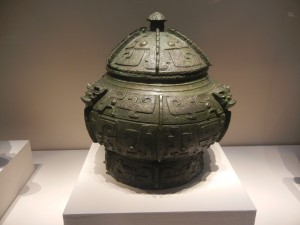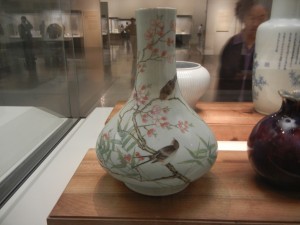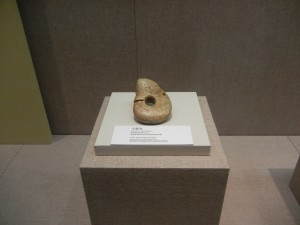Many old history books say that China was first unified under the Shang Dynasty around 1500 BCE, but modern archeology has been showing that a lot of Chinese art forms are much older.
And people over a much vaster area of land than what the Shang ruled created them. Chinese culture is richer than most people think.
The jade piece in the above shot was made by a culture that was much older than the Shang, and very far from its political center, the Hongshan culture. It thrived northeast of Beijing, around the Liao River–very far from the central Yellow River, which the Shang dominated. K.C. Chang, in The Cambridge History of Ancient China, wrote that this society flourished between 3000 and 2500 BCE (others have dated its beginnings back to the 5th millennium). But in spite of its antiquity and distance, you can see basic traits of Chinese culture in this jade piece.
For example, it’s in a swirling circular pattern. This became one of China’s most common art forms. Many Shang Dynasty bronzes, like the one above, are covered with patterns which resemble both clouds and the powers in nature.
This concept of the life-giving forces in nature as a circular flow of energies was later expressed in the familiar yin/yang patterns between late 1st millennium BCE. It then became foundational in Chinese landscape painting–theorists wrote that a painting must express the flow of life. The 18th century vase above shows this tenet as exquisitely as possible. The thicker forms represent yin, and the thin ones are yang. Neither dominates the other–both flow throughout the whole. The holistic circulation of energies is more important than focusing on one object (a Western preference from ancient Greece to modern times). This vase is the height of elegance, but it developed from an art form that’s at least 4,500 years old.
The Longshan jade dragon in the above photo also represents nature’s powers in a circular form.
Many settlements grew into cities during the Longshan period (3000-2000 BCE), and people traded artworks. They probably also plundered them during the period’s frequent wars–the growing polities were vying for dominance. Art forms thus spread, including the cong. As people all over the land exchanged these images, they coalesced into assumptions about the most basic patterns in nature. This sense of nature as a whole in which powers flow harmoniously and Longshan domestic life, which stressed collective labor, reinforced each other.
China was becoming Chinese long before any state dominated it. Qin Shihuang, who created the terra-cotta army, was following footsteps which were ancient even then.
Ancient Egyptian culture is also much older than most people think.
So is Indian culture.





Comments on this entry are closed.